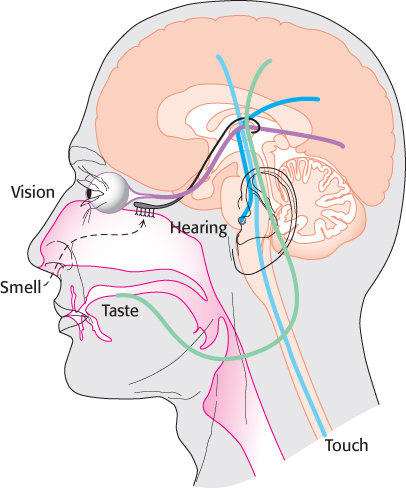Chapter Introduction

Color perception requires specific photoreceptors. The photoreceptor rhodopsin (right), which absorbs light in the process of vision, consists of the protein opsin and a bound vitamin A derivative, retinal. The amino acids (shown in red) that surround the retinal determine the color of light that is most efficiently absorbed. A person lacking a light-absorbing photoreceptor for the color green will see a bowl of fruits of many colors (left) as similar shades of yellow-green (middle).
OUTLINE
A Wide Variety of Organic Compounds Are Detected by Olfaction
Taste Is a Combination of Senses That Function by Different Mechanisms
Photoreceptor Molecules in the Eye Detect Visible Light
Hearing Depends on the Speedy Detection of Mechanical Stimuli
Touch Includes the Sensing of Pressure, Temperature, and Other Factors
Our senses provide us with means for detecting a diverse set of external signals, often with incredible sensitivity and specificity. For example, when fully adapted to a darkened room, our eyes allow us to sense very low levels of light, down to a limit of less than 10 photons. With more light, we are able to distinguish millions of colors. Through our senses of smell and taste, we are able to detect thousands of chemicals in our environment and sort them into categories: pleasant or unpleasant? healthful or toxic? Finally, we can perceive mechanical stimuli in the air and around us through our senses of hearing and touch.
How do our sensory systems work? How are the initial stimuli detected? How are these initial biochemical events transformed into perceptions and experiences? We have already encountered systems that sense and respond to chemical signals—namely, receptors that bind to growth factors and hormones. Our knowledge of these receptors and their associated signal-transduction pathways provides us with concepts and tools for unraveling some of the workings of sensory systems. For example, 7TM receptors (seven-transmembrane receptors; Section 14.1) play key roles in olfaction, taste, and vision. Ion channels that are sensitive to mechanical stress are essential for hearing and touch.
In this chapter, we focus on the five major sensory systems found in human beings and other mammals: olfaction (the sense of smell—i.e., the detection of small molecules in the air), taste, or gustation (the detection of selected organic compounds and ions by the tongue), vision (the detection of light), hearing (the detection of sound, or pressure waves in the air), and touch (the detection of changes in pressure, temperature, and other factors by the skin). Each of these primary sensory systems contains specialized sensory neurons that transmit nerve impulses to the central nervous system (Figure 33.1). In the central nervous system, these signals are processed and combined with other information to yield a perception that may trigger a change in behavior. By these means, our senses allow us to detect changes in our environments and to adjust our behavior appropriately.

Figure 33.1: Sensory connections to the brain. Sensory nerves connect sensory organs to the brain and spinal cord.

